Macrovascular Complications of Diabetes: Pathophysiology, Assessment, and Management
VerifiedAdded on 2023/06/04
|10
|2619
|460
AI Summary
This essay discusses the pathophysiology, assessment, and management of macrovascular complications of diabetes. It covers the diagnostic criteria, treatment, and management of the disease condition.
Contribute Materials
Your contribution can guide someone’s learning journey. Share your
documents today.

Running head: DIABETES
Diabetes
Name of the Student
Name of the University
Author Note
Diabetes
Name of the Student
Name of the University
Author Note
Secure Best Marks with AI Grader
Need help grading? Try our AI Grader for instant feedback on your assignments.
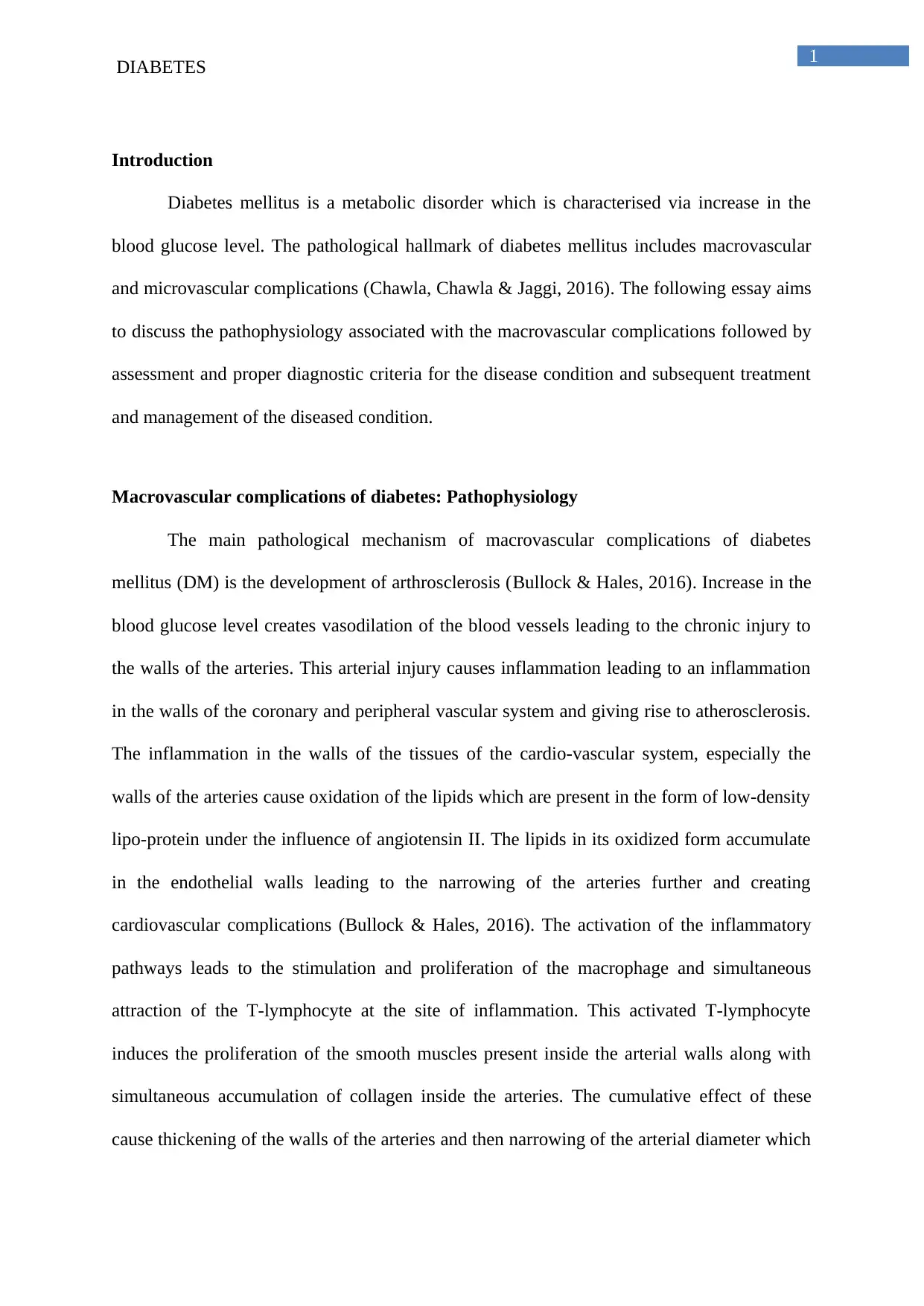
1
DIABETES
Introduction
Diabetes mellitus is a metabolic disorder which is characterised via increase in the
blood glucose level. The pathological hallmark of diabetes mellitus includes macrovascular
and microvascular complications (Chawla, Chawla & Jaggi, 2016). The following essay aims
to discuss the pathophysiology associated with the macrovascular complications followed by
assessment and proper diagnostic criteria for the disease condition and subsequent treatment
and management of the diseased condition.
Macrovascular complications of diabetes: Pathophysiology
The main pathological mechanism of macrovascular complications of diabetes
mellitus (DM) is the development of arthrosclerosis (Bullock & Hales, 2016). Increase in the
blood glucose level creates vasodilation of the blood vessels leading to the chronic injury to
the walls of the arteries. This arterial injury causes inflammation leading to an inflammation
in the walls of the coronary and peripheral vascular system and giving rise to atherosclerosis.
The inflammation in the walls of the tissues of the cardio-vascular system, especially the
walls of the arteries cause oxidation of the lipids which are present in the form of low-density
lipo-protein under the influence of angiotensin II. The lipids in its oxidized form accumulate
in the endothelial walls leading to the narrowing of the arteries further and creating
cardiovascular complications (Bullock & Hales, 2016). The activation of the inflammatory
pathways leads to the stimulation and proliferation of the macrophage and simultaneous
attraction of the T-lymphocyte at the site of inflammation. This activated T-lymphocyte
induces the proliferation of the smooth muscles present inside the arterial walls along with
simultaneous accumulation of collagen inside the arteries. The cumulative effect of these
cause thickening of the walls of the arteries and then narrowing of the arterial diameter which
DIABETES
Introduction
Diabetes mellitus is a metabolic disorder which is characterised via increase in the
blood glucose level. The pathological hallmark of diabetes mellitus includes macrovascular
and microvascular complications (Chawla, Chawla & Jaggi, 2016). The following essay aims
to discuss the pathophysiology associated with the macrovascular complications followed by
assessment and proper diagnostic criteria for the disease condition and subsequent treatment
and management of the diseased condition.
Macrovascular complications of diabetes: Pathophysiology
The main pathological mechanism of macrovascular complications of diabetes
mellitus (DM) is the development of arthrosclerosis (Bullock & Hales, 2016). Increase in the
blood glucose level creates vasodilation of the blood vessels leading to the chronic injury to
the walls of the arteries. This arterial injury causes inflammation leading to an inflammation
in the walls of the coronary and peripheral vascular system and giving rise to atherosclerosis.
The inflammation in the walls of the tissues of the cardio-vascular system, especially the
walls of the arteries cause oxidation of the lipids which are present in the form of low-density
lipo-protein under the influence of angiotensin II. The lipids in its oxidized form accumulate
in the endothelial walls leading to the narrowing of the arteries further and creating
cardiovascular complications (Bullock & Hales, 2016). The activation of the inflammatory
pathways leads to the stimulation and proliferation of the macrophage and simultaneous
attraction of the T-lymphocyte at the site of inflammation. This activated T-lymphocyte
induces the proliferation of the smooth muscles present inside the arterial walls along with
simultaneous accumulation of collagen inside the arteries. The cumulative effect of these
cause thickening of the walls of the arteries and then narrowing of the arterial diameter which

2
DIABETES
increases the severity of the atherosclerosis and thereby causing macrovascular complications
of diabetes (Marieb & Hoehn, 2015).
According to Chawla, Chawla and Jaggi (2016), diabetes is characterised by
hyperglycemia that is increase in the blood glucose level concentration. Hyperglycemia
promotes the adhesion of the macrophages and other phagocytic cells inside the arterial cells.
The adhesion of monocytes triggers type 1 hypersensitivity reaction under the influence of
the primary hypersensitivity mediators. The deposition of the release of the primary
mediators of the type 1 hypersensitivity reactions narrows the overall diameter of the arteries
further and increases the risk of cardiovascular accidents. Increase in the blood glucose level
cause activation of the matrix-degrading enzyme metalloproteinase which cause rupture of
plaque and arterial remodelling leading thickening of the arteries. Diabetes also causes
increase in the secretion of primary inflammatory mediators and inflammatory cytokines like
C-reactive protein, plasminogen activator, interleukine-6 that leads to activation of the
macrophage extravasations. Macrophage extravasations cause activation of the protein-kinase
pathway and inflict inflammatory reaction and increases vulnerability of developing
macrovascular complications of diabetes (Hartemann et al., 2013).
Increase rate of platelet adhesion and increase in the tendency of hypercoagulability is
another pathophysiology underlying the development of macrovascular complications
(Domingueti et al., 2016). Increased rate of platelet adhesion cause secretion of reactive
oxygen species (ROS). ROS causes increase in the generation of the free radicals with altered
calcium regulation promoting platelet aggregation. Platelet adhesion cause impaired nitric
oxide generation with increase in the secretion of plasminogen activator inhibitor type 1. This
causes fibrinolyisis in diabetic patients. Fibrinolysis causes activation of platelet coagulability
leading to vascular occlusion followed by a series of cardiovascular events. Such conditions
are more common among the patients with type 2 diabetes mellitus (Domingueti et al., 2016).
DIABETES
increases the severity of the atherosclerosis and thereby causing macrovascular complications
of diabetes (Marieb & Hoehn, 2015).
According to Chawla, Chawla and Jaggi (2016), diabetes is characterised by
hyperglycemia that is increase in the blood glucose level concentration. Hyperglycemia
promotes the adhesion of the macrophages and other phagocytic cells inside the arterial cells.
The adhesion of monocytes triggers type 1 hypersensitivity reaction under the influence of
the primary hypersensitivity mediators. The deposition of the release of the primary
mediators of the type 1 hypersensitivity reactions narrows the overall diameter of the arteries
further and increases the risk of cardiovascular accidents. Increase in the blood glucose level
cause activation of the matrix-degrading enzyme metalloproteinase which cause rupture of
plaque and arterial remodelling leading thickening of the arteries. Diabetes also causes
increase in the secretion of primary inflammatory mediators and inflammatory cytokines like
C-reactive protein, plasminogen activator, interleukine-6 that leads to activation of the
macrophage extravasations. Macrophage extravasations cause activation of the protein-kinase
pathway and inflict inflammatory reaction and increases vulnerability of developing
macrovascular complications of diabetes (Hartemann et al., 2013).
Increase rate of platelet adhesion and increase in the tendency of hypercoagulability is
another pathophysiology underlying the development of macrovascular complications
(Domingueti et al., 2016). Increased rate of platelet adhesion cause secretion of reactive
oxygen species (ROS). ROS causes increase in the generation of the free radicals with altered
calcium regulation promoting platelet aggregation. Platelet adhesion cause impaired nitric
oxide generation with increase in the secretion of plasminogen activator inhibitor type 1. This
causes fibrinolyisis in diabetic patients. Fibrinolysis causes activation of platelet coagulability
leading to vascular occlusion followed by a series of cardiovascular events. Such conditions
are more common among the patients with type 2 diabetes mellitus (Domingueti et al., 2016).
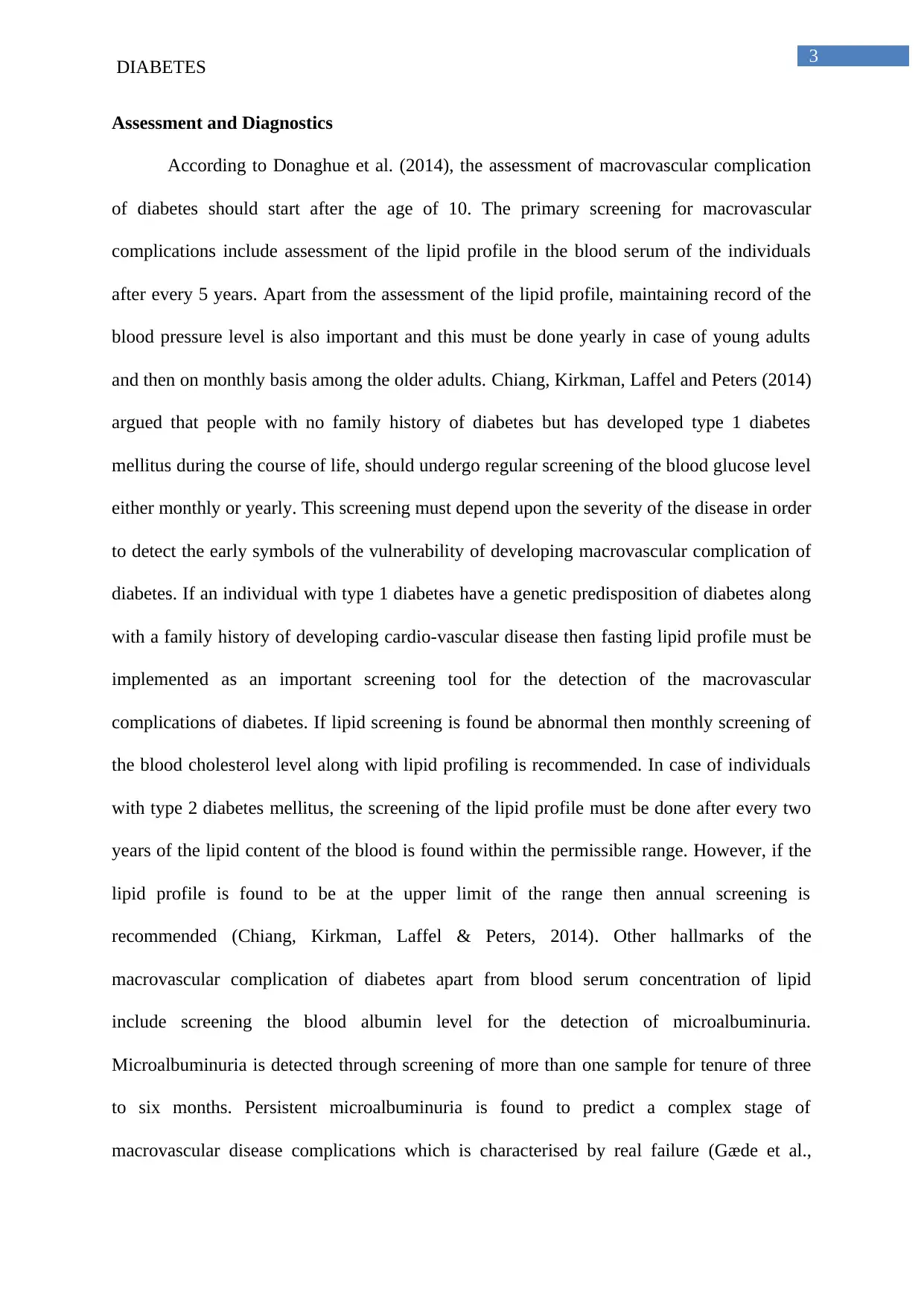
3
DIABETES
Assessment and Diagnostics
According to Donaghue et al. (2014), the assessment of macrovascular complication
of diabetes should start after the age of 10. The primary screening for macrovascular
complications include assessment of the lipid profile in the blood serum of the individuals
after every 5 years. Apart from the assessment of the lipid profile, maintaining record of the
blood pressure level is also important and this must be done yearly in case of young adults
and then on monthly basis among the older adults. Chiang, Kirkman, Laffel and Peters (2014)
argued that people with no family history of diabetes but has developed type 1 diabetes
mellitus during the course of life, should undergo regular screening of the blood glucose level
either monthly or yearly. This screening must depend upon the severity of the disease in order
to detect the early symbols of the vulnerability of developing macrovascular complication of
diabetes. If an individual with type 1 diabetes have a genetic predisposition of diabetes along
with a family history of developing cardio-vascular disease then fasting lipid profile must be
implemented as an important screening tool for the detection of the macrovascular
complications of diabetes. If lipid screening is found be abnormal then monthly screening of
the blood cholesterol level along with lipid profiling is recommended. In case of individuals
with type 2 diabetes mellitus, the screening of the lipid profile must be done after every two
years of the lipid content of the blood is found within the permissible range. However, if the
lipid profile is found to be at the upper limit of the range then annual screening is
recommended (Chiang, Kirkman, Laffel & Peters, 2014). Other hallmarks of the
macrovascular complication of diabetes apart from blood serum concentration of lipid
include screening the blood albumin level for the detection of microalbuminuria.
Microalbuminuria is detected through screening of more than one sample for tenure of three
to six months. Persistent microalbuminuria is found to predict a complex stage of
macrovascular disease complications which is characterised by real failure (Gæde et al.,
DIABETES
Assessment and Diagnostics
According to Donaghue et al. (2014), the assessment of macrovascular complication
of diabetes should start after the age of 10. The primary screening for macrovascular
complications include assessment of the lipid profile in the blood serum of the individuals
after every 5 years. Apart from the assessment of the lipid profile, maintaining record of the
blood pressure level is also important and this must be done yearly in case of young adults
and then on monthly basis among the older adults. Chiang, Kirkman, Laffel and Peters (2014)
argued that people with no family history of diabetes but has developed type 1 diabetes
mellitus during the course of life, should undergo regular screening of the blood glucose level
either monthly or yearly. This screening must depend upon the severity of the disease in order
to detect the early symbols of the vulnerability of developing macrovascular complication of
diabetes. If an individual with type 1 diabetes have a genetic predisposition of diabetes along
with a family history of developing cardio-vascular disease then fasting lipid profile must be
implemented as an important screening tool for the detection of the macrovascular
complications of diabetes. If lipid screening is found be abnormal then monthly screening of
the blood cholesterol level along with lipid profiling is recommended. In case of individuals
with type 2 diabetes mellitus, the screening of the lipid profile must be done after every two
years of the lipid content of the blood is found within the permissible range. However, if the
lipid profile is found to be at the upper limit of the range then annual screening is
recommended (Chiang, Kirkman, Laffel & Peters, 2014). Other hallmarks of the
macrovascular complication of diabetes apart from blood serum concentration of lipid
include screening the blood albumin level for the detection of microalbuminuria.
Microalbuminuria is detected through screening of more than one sample for tenure of three
to six months. Persistent microalbuminuria is found to predict a complex stage of
macrovascular disease complications which is characterised by real failure (Gæde et al.,
Secure Best Marks with AI Grader
Need help grading? Try our AI Grader for instant feedback on your assignments.
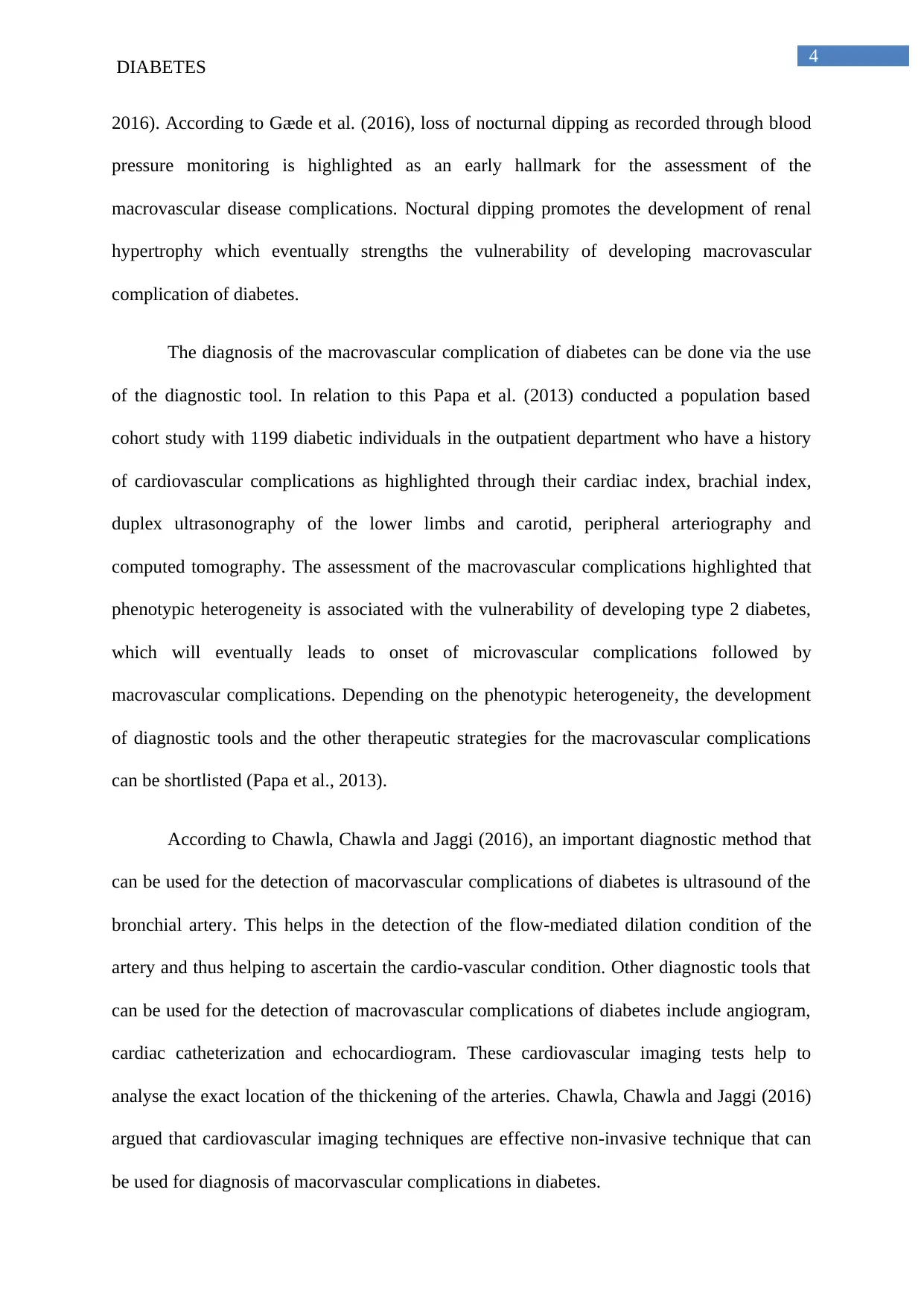
4
DIABETES
2016). According to Gæde et al. (2016), loss of nocturnal dipping as recorded through blood
pressure monitoring is highlighted as an early hallmark for the assessment of the
macrovascular disease complications. Noctural dipping promotes the development of renal
hypertrophy which eventually strengths the vulnerability of developing macrovascular
complication of diabetes.
The diagnosis of the macrovascular complication of diabetes can be done via the use
of the diagnostic tool. In relation to this Papa et al. (2013) conducted a population based
cohort study with 1199 diabetic individuals in the outpatient department who have a history
of cardiovascular complications as highlighted through their cardiac index, brachial index,
duplex ultrasonography of the lower limbs and carotid, peripheral arteriography and
computed tomography. The assessment of the macrovascular complications highlighted that
phenotypic heterogeneity is associated with the vulnerability of developing type 2 diabetes,
which will eventually leads to onset of microvascular complications followed by
macrovascular complications. Depending on the phenotypic heterogeneity, the development
of diagnostic tools and the other therapeutic strategies for the macrovascular complications
can be shortlisted (Papa et al., 2013).
According to Chawla, Chawla and Jaggi (2016), an important diagnostic method that
can be used for the detection of macorvascular complications of diabetes is ultrasound of the
bronchial artery. This helps in the detection of the flow-mediated dilation condition of the
artery and thus helping to ascertain the cardio-vascular condition. Other diagnostic tools that
can be used for the detection of macrovascular complications of diabetes include angiogram,
cardiac catheterization and echocardiogram. These cardiovascular imaging tests help to
analyse the exact location of the thickening of the arteries. Chawla, Chawla and Jaggi (2016)
argued that cardiovascular imaging techniques are effective non-invasive technique that can
be used for diagnosis of macorvascular complications in diabetes.
DIABETES
2016). According to Gæde et al. (2016), loss of nocturnal dipping as recorded through blood
pressure monitoring is highlighted as an early hallmark for the assessment of the
macrovascular disease complications. Noctural dipping promotes the development of renal
hypertrophy which eventually strengths the vulnerability of developing macrovascular
complication of diabetes.
The diagnosis of the macrovascular complication of diabetes can be done via the use
of the diagnostic tool. In relation to this Papa et al. (2013) conducted a population based
cohort study with 1199 diabetic individuals in the outpatient department who have a history
of cardiovascular complications as highlighted through their cardiac index, brachial index,
duplex ultrasonography of the lower limbs and carotid, peripheral arteriography and
computed tomography. The assessment of the macrovascular complications highlighted that
phenotypic heterogeneity is associated with the vulnerability of developing type 2 diabetes,
which will eventually leads to onset of microvascular complications followed by
macrovascular complications. Depending on the phenotypic heterogeneity, the development
of diagnostic tools and the other therapeutic strategies for the macrovascular complications
can be shortlisted (Papa et al., 2013).
According to Chawla, Chawla and Jaggi (2016), an important diagnostic method that
can be used for the detection of macorvascular complications of diabetes is ultrasound of the
bronchial artery. This helps in the detection of the flow-mediated dilation condition of the
artery and thus helping to ascertain the cardio-vascular condition. Other diagnostic tools that
can be used for the detection of macrovascular complications of diabetes include angiogram,
cardiac catheterization and echocardiogram. These cardiovascular imaging tests help to
analyse the exact location of the thickening of the arteries. Chawla, Chawla and Jaggi (2016)
argued that cardiovascular imaging techniques are effective non-invasive technique that can
be used for diagnosis of macorvascular complications in diabetes.

5
DIABETES
Treatment and management
The core of treatment and management of macrovascular complications of diabetes
include proper physical exercise, observance of healthy lifestyle and diet, disease education
and psychological support. Medical nutritional therapy is regarded as an important means for
the management and treatment of MVD. The medical nutrition therapy mainly promotes
healthy eating patterns which emphasize on the consumption of nutritional food rich in fruits
and green vegetables (Brown, Edwards, Seaton & Buckley, 2015). Increase in the
consumption of fruits and green vegetables and decrease in the consumption of carbohydrate,
fat and sugar promotes reduction in the lipid content of the body along with the reduction in
the blood glucose level. This nutritional diet plan must be devised based on basal metabolic
index of individual under the controlled supervision of a professional dietician (Brown,
Edwards, Seaton & Buckley, 2015). Physical activity is another important aspect for effective
regulation of macrovascular disease complication in diabetes. Increase in the physical activity
reduces the overall sedentary time and thus increasing the provision for burning of the extra
calories and decrease in the overall blood glucose level. Rigorous physical activity is
recommended for the young adults and mild to moderate physical activity like 15 to 30
minutes walk is ideal for the older adults who are above 60-year (Brown, Edwards, Seaton &
Buckley, 2015). According to American Diabetes Association (2015) smoking cessation and
reduction in the consumption of alcohol helps to decrease the severity of diabetes and thus
decreasing the chance of developing macrovascular complications.
The treatment of macorvascular disease complication in case of diabetes can be done
via the use of the subcutaneous insulin injection in order to effectively manage the
hyperglycaemic shocks and this reducing the chance of developing macrovascular
complications from hyperglycemia. However, the dosage of insulin needs to be adjusted as
per the prevailing blood glucose level, body mass index and age of the patient (Brotto &
DIABETES
Treatment and management
The core of treatment and management of macrovascular complications of diabetes
include proper physical exercise, observance of healthy lifestyle and diet, disease education
and psychological support. Medical nutritional therapy is regarded as an important means for
the management and treatment of MVD. The medical nutrition therapy mainly promotes
healthy eating patterns which emphasize on the consumption of nutritional food rich in fruits
and green vegetables (Brown, Edwards, Seaton & Buckley, 2015). Increase in the
consumption of fruits and green vegetables and decrease in the consumption of carbohydrate,
fat and sugar promotes reduction in the lipid content of the body along with the reduction in
the blood glucose level. This nutritional diet plan must be devised based on basal metabolic
index of individual under the controlled supervision of a professional dietician (Brown,
Edwards, Seaton & Buckley, 2015). Physical activity is another important aspect for effective
regulation of macrovascular disease complication in diabetes. Increase in the physical activity
reduces the overall sedentary time and thus increasing the provision for burning of the extra
calories and decrease in the overall blood glucose level. Rigorous physical activity is
recommended for the young adults and mild to moderate physical activity like 15 to 30
minutes walk is ideal for the older adults who are above 60-year (Brown, Edwards, Seaton &
Buckley, 2015). According to American Diabetes Association (2015) smoking cessation and
reduction in the consumption of alcohol helps to decrease the severity of diabetes and thus
decreasing the chance of developing macrovascular complications.
The treatment of macorvascular disease complication in case of diabetes can be done
via the use of the subcutaneous insulin injection in order to effectively manage the
hyperglycaemic shocks and this reducing the chance of developing macrovascular
complications from hyperglycemia. However, the dosage of insulin needs to be adjusted as
per the prevailing blood glucose level, body mass index and age of the patient (Brotto &

6
DIABETES
Rafferty, 2016). The management of macrovascular complication of diabetes can be done
further via managing high blood cholesterol level and blood serum of lipid under the
application of effective pharmacological interventions (Bullock & Manias, 2016).
Conclusion
Thus from the above discussion, it can be concluded that macrovascular
complications of diabetes mellitus mainly arise from inflammation in the walls of the arteries.
Arterial inflammation leads to the thickening of the arterial wall followed by narrowing of the
arterial diameter. This leads to the development atherosclerosis followed by marcovascular
complications. The main diagnostic tool used for the detection of macrovascular complication
include cardiovascular imaging techniques and periodic check-up of the blood glucose level
and lipid level of the blood helps in the assessment of macrovascular complications. The
management of the condition can be done via observance of healthy lifestyle. The treatment
of the disease can be done via proper medication management.
DIABETES
Rafferty, 2016). The management of macrovascular complication of diabetes can be done
further via managing high blood cholesterol level and blood serum of lipid under the
application of effective pharmacological interventions (Bullock & Manias, 2016).
Conclusion
Thus from the above discussion, it can be concluded that macrovascular
complications of diabetes mellitus mainly arise from inflammation in the walls of the arteries.
Arterial inflammation leads to the thickening of the arterial wall followed by narrowing of the
arterial diameter. This leads to the development atherosclerosis followed by marcovascular
complications. The main diagnostic tool used for the detection of macrovascular complication
include cardiovascular imaging techniques and periodic check-up of the blood glucose level
and lipid level of the blood helps in the assessment of macrovascular complications. The
management of the condition can be done via observance of healthy lifestyle. The treatment
of the disease can be done via proper medication management.
Paraphrase This Document
Need a fresh take? Get an instant paraphrase of this document with our AI Paraphraser
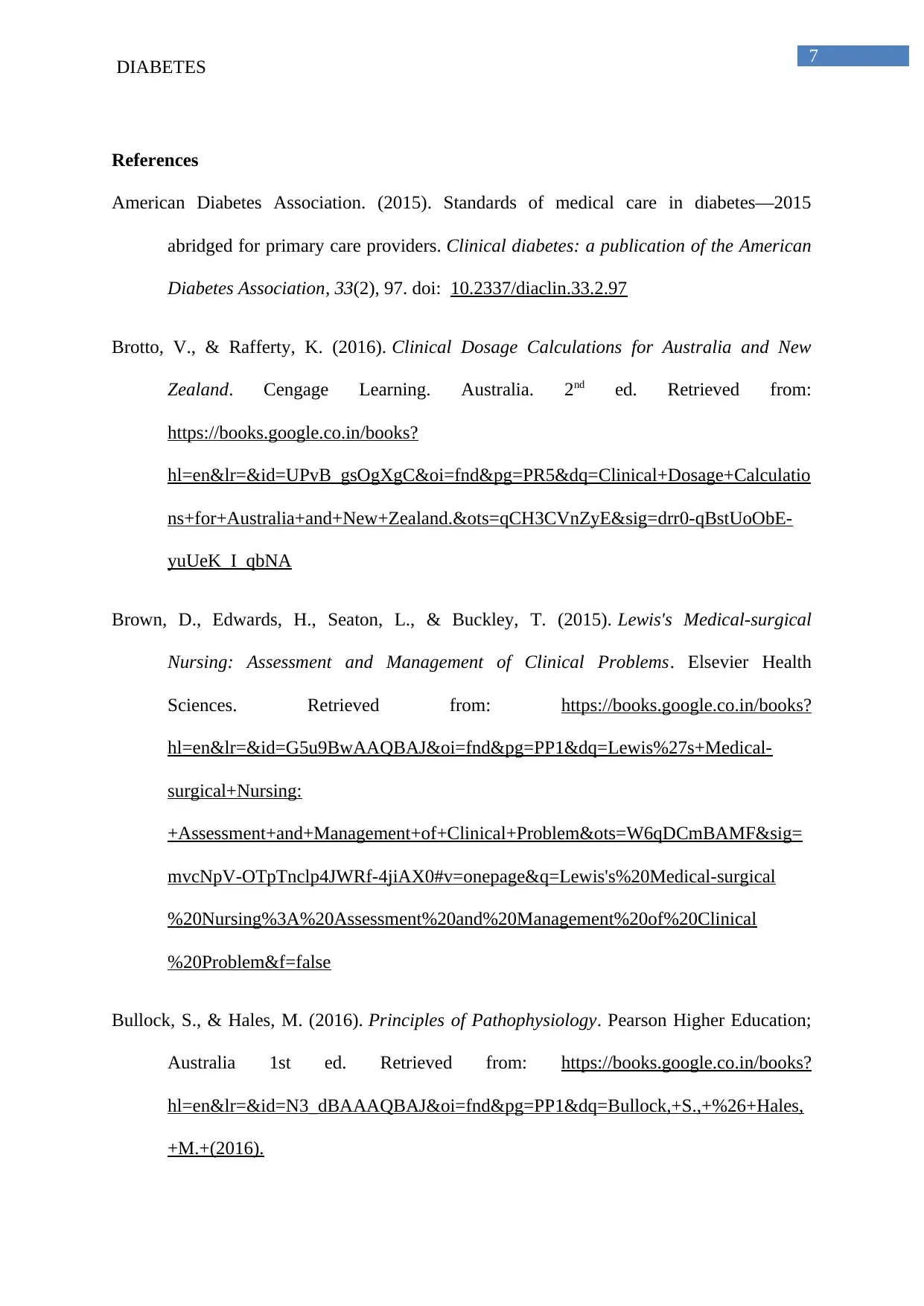
7
DIABETES
References
American Diabetes Association. (2015). Standards of medical care in diabetes—2015
abridged for primary care providers. Clinical diabetes: a publication of the American
Diabetes Association, 33(2), 97. doi: 10.2337/diaclin.33.2.97
Brotto, V., & Rafferty, K. (2016). Clinical Dosage Calculations for Australia and New
Zealand. Cengage Learning. Australia. 2nd ed. Retrieved from:
https://books.google.co.in/books?
hl=en&lr=&id=UPvB_gsOgXgC&oi=fnd&pg=PR5&dq=Clinical+Dosage+Calculatio
ns+for+Australia+and+New+Zealand.&ots=qCH3CVnZyE&sig=drr0-qBstUoObE-
yuUeK_I_qbNA
Brown, D., Edwards, H., Seaton, L., & Buckley, T. (2015). Lewis's Medical-surgical
Nursing: Assessment and Management of Clinical Problems. Elsevier Health
Sciences. Retrieved from: https://books.google.co.in/books?
hl=en&lr=&id=G5u9BwAAQBAJ&oi=fnd&pg=PP1&dq=Lewis%27s+Medical-
surgical+Nursing:
+Assessment+and+Management+of+Clinical+Problem&ots=W6qDCmBAMF&sig=
mvcNpV-OTpTnclp4JWRf-4jiAX0#v=onepage&q=Lewis's%20Medical-surgical
%20Nursing%3A%20Assessment%20and%20Management%20of%20Clinical
%20Problem&f=false
Bullock, S., & Hales, M. (2016). Principles of Pathophysiology. Pearson Higher Education;
Australia 1st ed. Retrieved from: https://books.google.co.in/books?
hl=en&lr=&id=N3_dBAAAQBAJ&oi=fnd&pg=PP1&dq=Bullock,+S.,+%26+Hales,
+M.+(2016).
DIABETES
References
American Diabetes Association. (2015). Standards of medical care in diabetes—2015
abridged for primary care providers. Clinical diabetes: a publication of the American
Diabetes Association, 33(2), 97. doi: 10.2337/diaclin.33.2.97
Brotto, V., & Rafferty, K. (2016). Clinical Dosage Calculations for Australia and New
Zealand. Cengage Learning. Australia. 2nd ed. Retrieved from:
https://books.google.co.in/books?
hl=en&lr=&id=UPvB_gsOgXgC&oi=fnd&pg=PR5&dq=Clinical+Dosage+Calculatio
ns+for+Australia+and+New+Zealand.&ots=qCH3CVnZyE&sig=drr0-qBstUoObE-
yuUeK_I_qbNA
Brown, D., Edwards, H., Seaton, L., & Buckley, T. (2015). Lewis's Medical-surgical
Nursing: Assessment and Management of Clinical Problems. Elsevier Health
Sciences. Retrieved from: https://books.google.co.in/books?
hl=en&lr=&id=G5u9BwAAQBAJ&oi=fnd&pg=PP1&dq=Lewis%27s+Medical-
surgical+Nursing:
+Assessment+and+Management+of+Clinical+Problem&ots=W6qDCmBAMF&sig=
mvcNpV-OTpTnclp4JWRf-4jiAX0#v=onepage&q=Lewis's%20Medical-surgical
%20Nursing%3A%20Assessment%20and%20Management%20of%20Clinical
%20Problem&f=false
Bullock, S., & Hales, M. (2016). Principles of Pathophysiology. Pearson Higher Education;
Australia 1st ed. Retrieved from: https://books.google.co.in/books?
hl=en&lr=&id=N3_dBAAAQBAJ&oi=fnd&pg=PP1&dq=Bullock,+S.,+%26+Hales,
+M.+(2016).
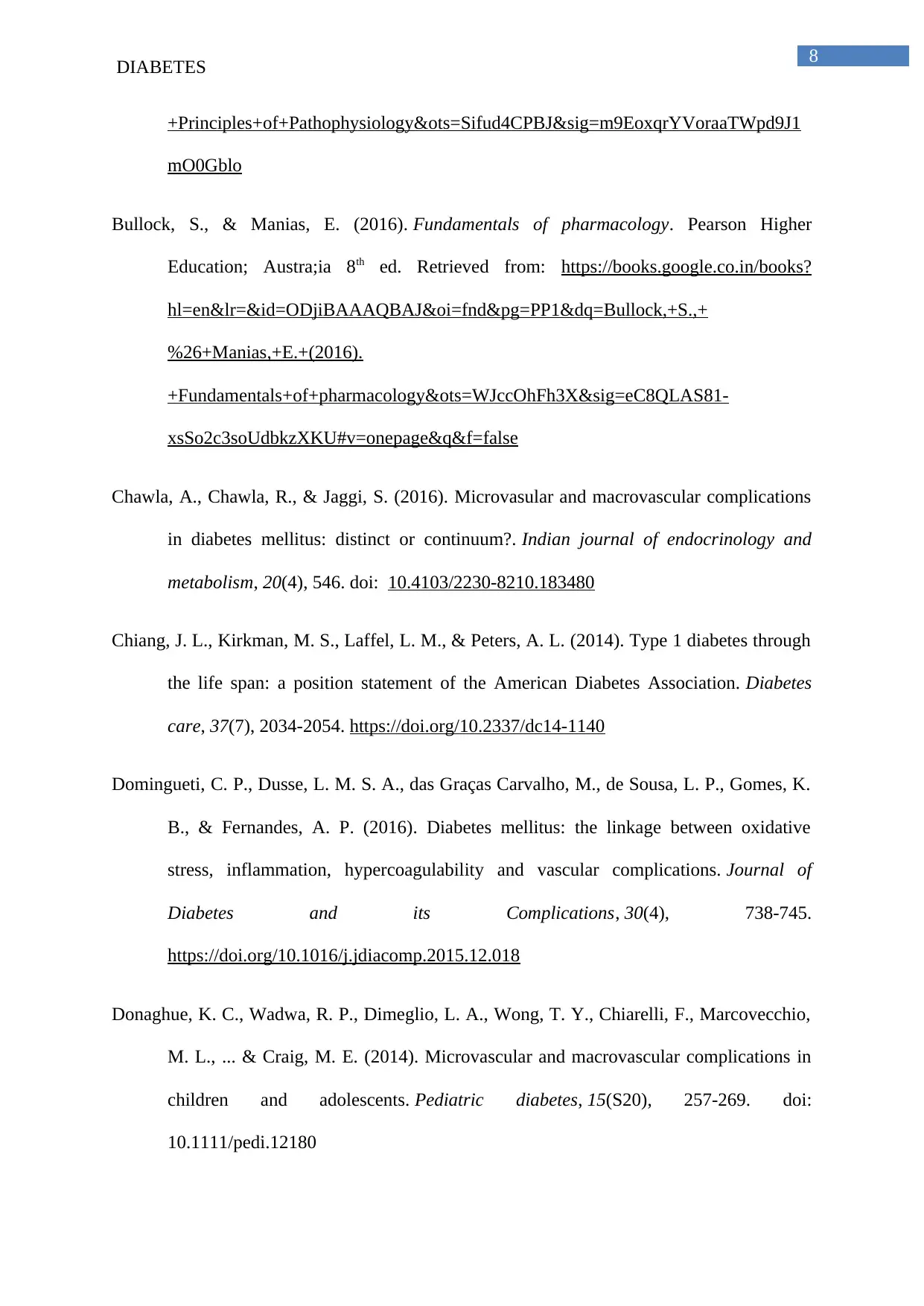
8
DIABETES
+Principles+of+Pathophysiology&ots=Sifud4CPBJ&sig=m9EoxqrYVoraaTWpd9J1
mO0Gblo
Bullock, S., & Manias, E. (2016). Fundamentals of pharmacology. Pearson Higher
Education; Austra;ia 8th ed. Retrieved from: https://books.google.co.in/books?
hl=en&lr=&id=ODjiBAAAQBAJ&oi=fnd&pg=PP1&dq=Bullock,+S.,+
%26+Manias,+E.+(2016).
+Fundamentals+of+pharmacology&ots=WJccOhFh3X&sig=eC8QLAS81-
xsSo2c3soUdbkzXKU#v=onepage&q&f=false
Chawla, A., Chawla, R., & Jaggi, S. (2016). Microvasular and macrovascular complications
in diabetes mellitus: distinct or continuum?. Indian journal of endocrinology and
metabolism, 20(4), 546. doi: 10.4103/2230-8210.183480
Chiang, J. L., Kirkman, M. S., Laffel, L. M., & Peters, A. L. (2014). Type 1 diabetes through
the life span: a position statement of the American Diabetes Association. Diabetes
care, 37(7), 2034-2054. https://doi.org/10.2337/dc14-1140
Domingueti, C. P., Dusse, L. M. S. A., das Graças Carvalho, M., de Sousa, L. P., Gomes, K.
B., & Fernandes, A. P. (2016). Diabetes mellitus: the linkage between oxidative
stress, inflammation, hypercoagulability and vascular complications. Journal of
Diabetes and its Complications, 30(4), 738-745.
https://doi.org/10.1016/j.jdiacomp.2015.12.018
Donaghue, K. C., Wadwa, R. P., Dimeglio, L. A., Wong, T. Y., Chiarelli, F., Marcovecchio,
M. L., ... & Craig, M. E. (2014). Microvascular and macrovascular complications in
children and adolescents. Pediatric diabetes, 15(S20), 257-269. doi:
10.1111/pedi.12180
DIABETES
+Principles+of+Pathophysiology&ots=Sifud4CPBJ&sig=m9EoxqrYVoraaTWpd9J1
mO0Gblo
Bullock, S., & Manias, E. (2016). Fundamentals of pharmacology. Pearson Higher
Education; Austra;ia 8th ed. Retrieved from: https://books.google.co.in/books?
hl=en&lr=&id=ODjiBAAAQBAJ&oi=fnd&pg=PP1&dq=Bullock,+S.,+
%26+Manias,+E.+(2016).
+Fundamentals+of+pharmacology&ots=WJccOhFh3X&sig=eC8QLAS81-
xsSo2c3soUdbkzXKU#v=onepage&q&f=false
Chawla, A., Chawla, R., & Jaggi, S. (2016). Microvasular and macrovascular complications
in diabetes mellitus: distinct or continuum?. Indian journal of endocrinology and
metabolism, 20(4), 546. doi: 10.4103/2230-8210.183480
Chiang, J. L., Kirkman, M. S., Laffel, L. M., & Peters, A. L. (2014). Type 1 diabetes through
the life span: a position statement of the American Diabetes Association. Diabetes
care, 37(7), 2034-2054. https://doi.org/10.2337/dc14-1140
Domingueti, C. P., Dusse, L. M. S. A., das Graças Carvalho, M., de Sousa, L. P., Gomes, K.
B., & Fernandes, A. P. (2016). Diabetes mellitus: the linkage between oxidative
stress, inflammation, hypercoagulability and vascular complications. Journal of
Diabetes and its Complications, 30(4), 738-745.
https://doi.org/10.1016/j.jdiacomp.2015.12.018
Donaghue, K. C., Wadwa, R. P., Dimeglio, L. A., Wong, T. Y., Chiarelli, F., Marcovecchio,
M. L., ... & Craig, M. E. (2014). Microvascular and macrovascular complications in
children and adolescents. Pediatric diabetes, 15(S20), 257-269. doi:
10.1111/pedi.12180
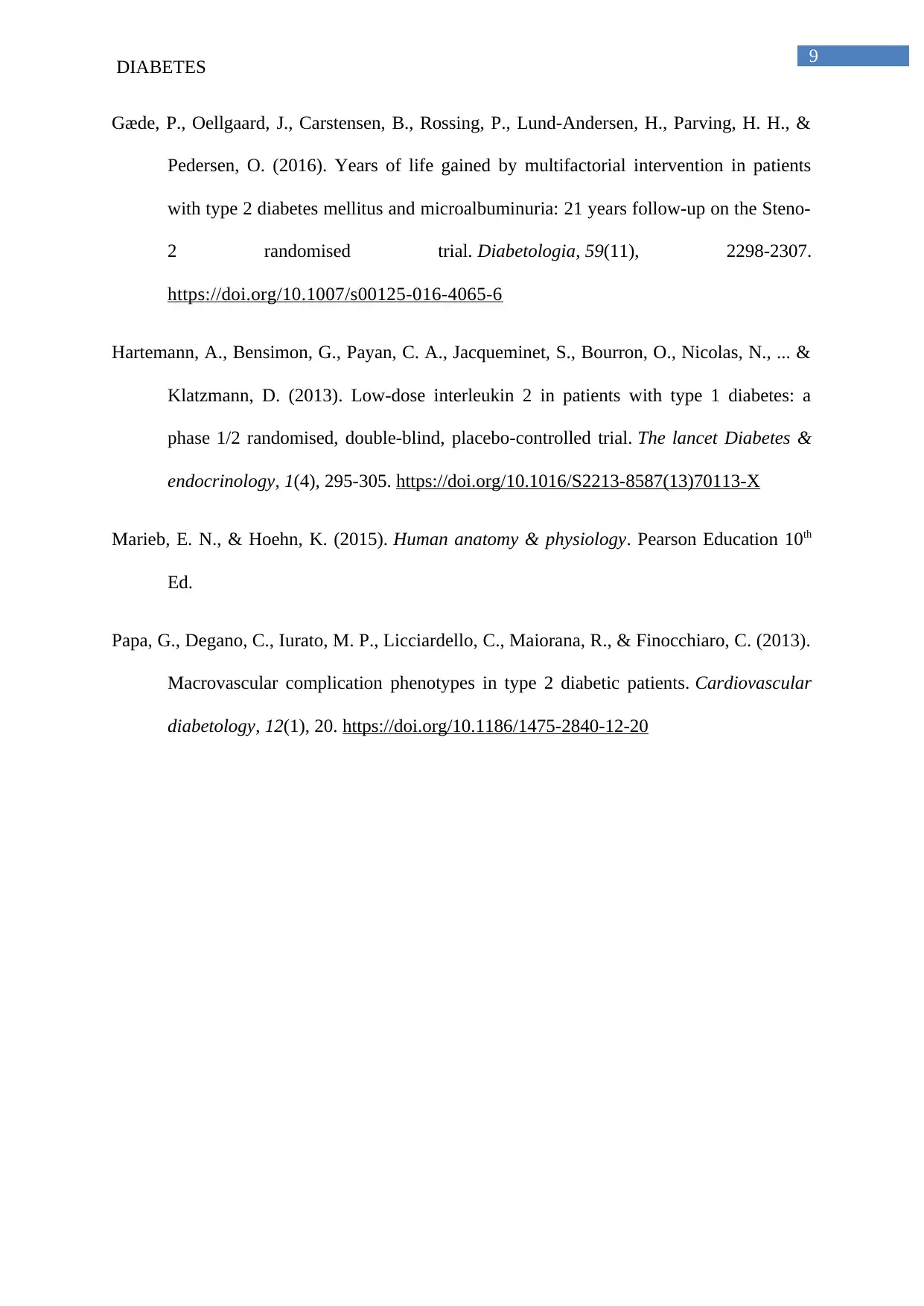
9
DIABETES
Gæde, P., Oellgaard, J., Carstensen, B., Rossing, P., Lund-Andersen, H., Parving, H. H., &
Pedersen, O. (2016). Years of life gained by multifactorial intervention in patients
with type 2 diabetes mellitus and microalbuminuria: 21 years follow-up on the Steno-
2 randomised trial. Diabetologia, 59(11), 2298-2307.
https://doi.org/10.1007/s00125-016-4065-6
Hartemann, A., Bensimon, G., Payan, C. A., Jacqueminet, S., Bourron, O., Nicolas, N., ... &
Klatzmann, D. (2013). Low-dose interleukin 2 in patients with type 1 diabetes: a
phase 1/2 randomised, double-blind, placebo-controlled trial. The lancet Diabetes &
endocrinology, 1(4), 295-305. https://doi.org/10.1016/S2213-8587(13)70113-X
Marieb, E. N., & Hoehn, K. (2015). Human anatomy & physiology. Pearson Education 10th
Ed.
Papa, G., Degano, C., Iurato, M. P., Licciardello, C., Maiorana, R., & Finocchiaro, C. (2013).
Macrovascular complication phenotypes in type 2 diabetic patients. Cardiovascular
diabetology, 12(1), 20. https://doi.org/10.1186/1475-2840-12-20
DIABETES
Gæde, P., Oellgaard, J., Carstensen, B., Rossing, P., Lund-Andersen, H., Parving, H. H., &
Pedersen, O. (2016). Years of life gained by multifactorial intervention in patients
with type 2 diabetes mellitus and microalbuminuria: 21 years follow-up on the Steno-
2 randomised trial. Diabetologia, 59(11), 2298-2307.
https://doi.org/10.1007/s00125-016-4065-6
Hartemann, A., Bensimon, G., Payan, C. A., Jacqueminet, S., Bourron, O., Nicolas, N., ... &
Klatzmann, D. (2013). Low-dose interleukin 2 in patients with type 1 diabetes: a
phase 1/2 randomised, double-blind, placebo-controlled trial. The lancet Diabetes &
endocrinology, 1(4), 295-305. https://doi.org/10.1016/S2213-8587(13)70113-X
Marieb, E. N., & Hoehn, K. (2015). Human anatomy & physiology. Pearson Education 10th
Ed.
Papa, G., Degano, C., Iurato, M. P., Licciardello, C., Maiorana, R., & Finocchiaro, C. (2013).
Macrovascular complication phenotypes in type 2 diabetic patients. Cardiovascular
diabetology, 12(1), 20. https://doi.org/10.1186/1475-2840-12-20
1 out of 10
Your All-in-One AI-Powered Toolkit for Academic Success.
+13062052269
info@desklib.com
Available 24*7 on WhatsApp / Email
![[object Object]](/_next/static/media/star-bottom.7253800d.svg)
Unlock your academic potential
© 2024 | Zucol Services PVT LTD | All rights reserved.



